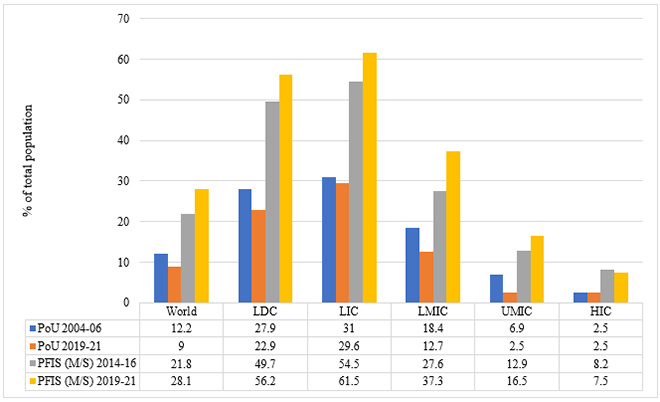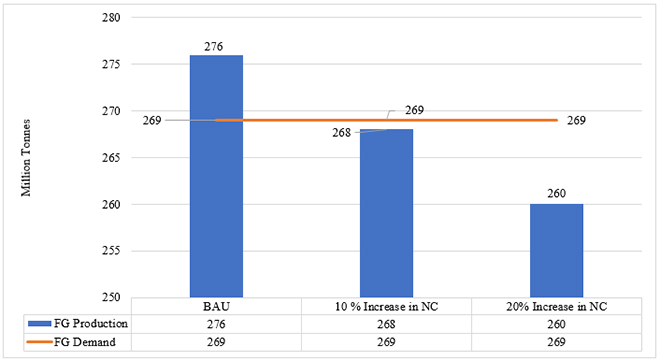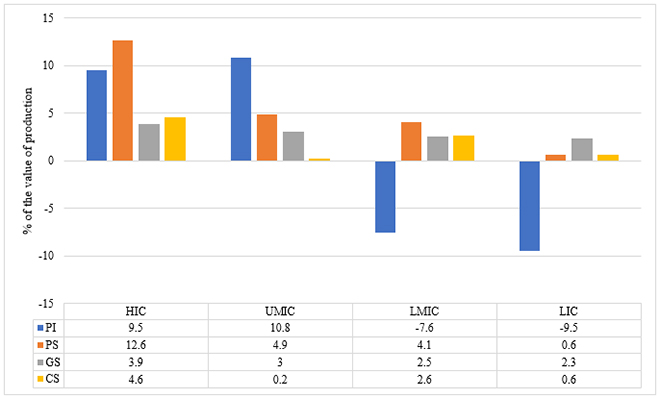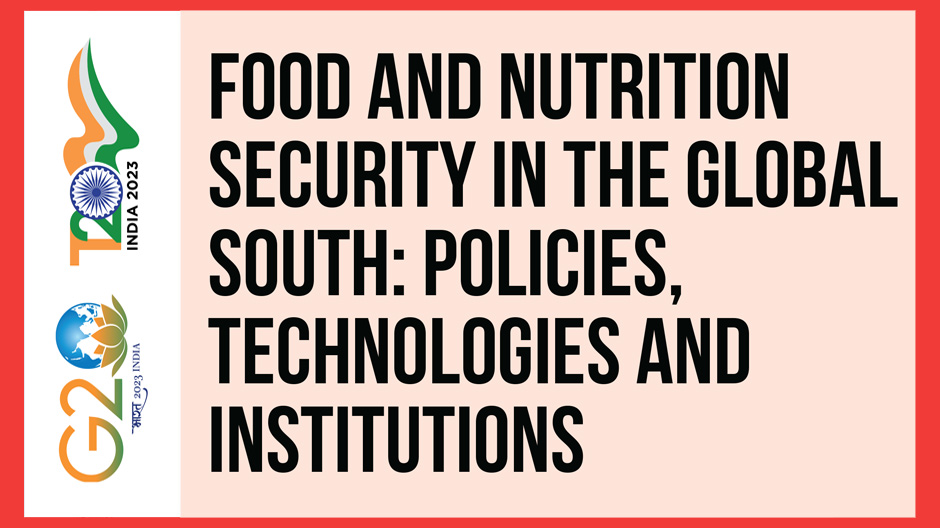Task Force 6: Accelerating SDGs: Exploring New Pathways to the 2030 Agenda
Abstract
Food and nutrition security has regressed in countries of the Global South, necessitating a comprehensive approach to addressing the complex linkages between food and nutrition, and other sectors. This Policy Brief examines the current state of food and nutrition security in least developed countries (LDCs) and proposes interventions in the production, processing and consumption sectors. Adopting appropriate technologies can enhance production and processing efficiency, while policies can ensure sustainable practices at the grassroots level. Institutions play a vital role in bridging the gap between policies and implementation, facilitating behavioural changes at the household level. To support LDCs, high-income countries (HICs) should offer technology transfer, policy guidance and institutional support. Moreover, agricultural policies must be realigned to increase public investment in agriculture, and LDCs should be provided with fair opportunities in international markets.
1. The Challenge
The latest assessment of global food and nutrition security indicates that the world has been moving backwards in recent years consequent to the pandemic and the Russia-Ukraine conflict (FAO et al., 2022). While three-year (2019–2021) averages indicate an improvement in nutrition (i.e. reduction in the prevalence of undernourishment), food security has deteriorated across most countries (excluding HICs). Low-income and LDCs are experiencing the greatest rates of food and nutrition insecurity, estimated at over 50 percent and 25 percent, respectively (see Fig. 1).
Fig. 1: Changing Food and Nutrition Security (World, and by Income)

Note: PoU = Prevalence of undernourishment; PFIS (M/S) = Prevalence of food insecurity (moderate and severe); LDC = Least developed countries; LIC = Low-income countries; LMIC = Lower middle-income countries; UMIC = Upper middle-income countries; HIC = High-income countries
Source: FAO et al. (2022)
The prevailing recessionary conditions are likely to exacerbate the global situation further. Checking and reversing the regressive trends are a policy concern of the G20 countries. While food security is directly linked to food production (availability) and access (affordability), nutrition security is connected with other sectors, such as water and sanitation, cultural and behavioural factors, and microenvironment. Food and nutrition policies hitherto followed in developing countries are mostly on the supply-side (public distribution systems) with a specific focus on increasing access to and consumption of nutritious food in poor households. Though policies have helped improve the food and nutrition security of targeted groups in the short run, their effectiveness and sustainability is limited because of the low nutrition density of foods and changing food habits.
Some countries in the Global South are facing a deficit in food production and import constraints (economic and market). The COVID-19 pandemic and the Russia-Ukraine conflict have aggravated the constraints on supply as well as demand in most countries. Food inflation and recession are likely to perpetuate food insecurity conditions. Besides, the nutrition density of foods in developing countries is low because of poor production practices, processes, storage and transport (Jena and Reddy, 2009; Kurian et al., 2013). The cost of nutritious food has also risen in recent years (FAO et al., 2022). Furthermore, although the demand for processed food is increasing, the nutritional quality of these foods is low due to inferior processing and packaging. In the absence of appropriate measures to make the entire food supply chain nutrition-sensitive, supply-side interventions remain ineffective in achieving food and nutrition security. At the same time, there is little understanding and awareness about nutrition at the household or individual level. The policy focus, therefore, needs to be on all three sectors (production, processing and consumption).
This Policy Brief aims to establish the criticality of a comprehensive view of the three sectors. It also discusses the role of technologies, policies and institutions in addressing the existing anomalies/distortions in the three sectors and how the G20 can help the Global South tackle these discrepancies and achieve sustainable food and nutrition security. Food and nutrition security is a complex issue that cannot be addressed by linear approaches. The three key sectors involved in food and nutrition security are agriculture (production), industry (processing), and households (consumption). To ensure sustainability, policies and strategies must focus on making these sectors nutrition-sensitive while maintaining productivity. While ensuring food availability, access, utilisation and stability—which are critical to food security—the formulation of effective nutrition strategies requires considering household preferences, cultural practices and behaviour towards nutrition.
The following paragraphs explore the challenges to addressing food and nutrition security in these three interlinked sectors.
The Production (Agriculture) Sector
Reducing the crop yield gap is a massive challenge to addressing food security issues in most developing countries. Among the countries in Asia, the yield gap in paddy is as high as 180 percent in Pakistan. (The lowest is at 5 percent, in Taiwan.) China has the highest yields, followed by Japan, South Korea and Vietnam. Pakistan has the lowest yield, followed by Thailand, Myanmar and India (Reddy and Rahut, 2023). The crop yield gaps in countries are a result of gaps in technology (access to seeds), resources (access to fertilisers, water), and efficiency (Silva et al., 2022). Climate change is compounding the problems of productivity and crop choices. In the absence of reliable climate forecasting (accurate early warning systems), farmers find it difficult to decide on appropriate crops and sowing periods.
Given the high prevalence of undernourishment, countries such as India are promoting nutrition-rich cereals (nutri-cereals), including maize, bajra, jowar and other millets, in place of rice and wheat. However, there is a tradeoff between yield and nutrition; in other words, the move towards nutri-cereals is likely to affect the overall food production, given the differences between the yield of rice/wheat and that of nutri-cereals. It is estimated that a mere 10-percent increase in the cultivation area for nutri-cereals can push India below the self-sufficiency level (from being a net exporter to being a net importer of food grains) (see Fig. 2). This will adversely affect the zero-hunger (calorie-based) SDG.
Fig. 2: Food Grain Production and Demand with a Shift Towards Nutri-cereals in India (2020)

Note: FG = Food grain; BAU = Business as usual; NC = Nutri-cereals
Source: Reddy (2022)
Concerns over food quality are also growing, with issues arising from untreated wastewater being used for irrigation and excessive use of chemicals, such as fertilisers, pesticides and plant hormones. Developing countries are particularly affected as studies reveal that grains and vegetables often contain effluents and sewage residues (Reddy and Behera, 2006; Jeena and Reddy, 2009). Using plant growth hormones to hasten and increase production has adverse effects on food nutrition density and poses health risks. The spread of wastewater agriculture also affects the quality of livestock fodder. Dairy farmers often use bovine growth hormones (Khaniki, 2007). Ensuring food quality in unprocessed food and dairy products is a challenge due to the absence of quality standards, monitoring and enforcement. Direct farm-to-table no longer ensures nutritious consumption; therefore, developing countries must balance the objectives of quantity versus quality.
The Processing (Industry) Sector
Consumer preferences are tilting towards processed foods, resulting in the processing sector’s growing contribution to the consumer basket and Gross Domestic Product (GDP) over the years. Food processing has the potential to benefit the production sector by enhancing the value of primary products and providing better prices for farmers. However, the nutritional quality of primary food products is low due to poor production processes and often, the processing of these products further diminishes their nutritional value. Moreover, processed foods are often harmful because of the addition of ingredients such as saturated fats and preservatives, and their nutritional value is further reduced by low-quality processing, packaging and transportation. The use of cheap plastics for packaging, crude transport systems and inadequate storage facilities diminishes nutritional value. In many developing countries, there are no scientific standards in place to regulate the industry, resulting in the negative health impact of processed foods. Although some high-quality processing and packaging methods exist, these are often too expensive for most. The aim should be to strike a balance between processing and nutritional density.
The Consumption (Household) Sector
Achievement of food security (zero hunger) in households relies on economic factors and food availability, while nutrition security is influenced by sociocultural, behavioural and environmental factors, such as access to safe water and sanitation, hygiene practices and microenvironment. It is not guaranteed that high-income households will practise good nutrition, as unhealthy processed foods can lead to obesity. Knowledge and awareness are crucial at the household level to ensure and maintain nutrition security. However, poor education and a lack of understanding of the connection between nutrition and wellbeing have resulted in low demand for nutrition at the household or individual level, particularly among the poor.
Even though food habits and cultural practices affect nutrition, these are changing due to exposure to new lifestyles and market influences. A household’s nutritional behaviour can be classified into three typologies: sensitive, neutral, and indifferent. These are based on four indicators: quantity, quality, frequency and timeliness of food consumption (see Fig. 3). The nutritional behaviour typologies have strong to weak linkages with the indicators. The behaviour patterns differ between urban and rural areas and across regions, influenced by various drivers from different sectors. Therefore, developing targeted and specific policy strategies (demand/supply and sectoral) for each typology is crucial.
Fig. 3: Household Typologies and Nutrition Security

Source: Authors’ own
Combined food and nutrition security may be defined as the “status and condition of individuals having access to enough food to mitigate hunger and combination of food that would provide the energy required to lead a normal, active and healthy life” (adapted from FAO, 2009 & 2012; FAO et al., 2022). This requires a multipronged approach covering interventions related to technologies, policies and institutions that can address the food and nutrition security challenges in the three sectors (see Table 1). The importance of these interventions may vary across sectors, with all three being critical in the production sector and technological and policy interventions assuming greater significance in processing and consumption. Institutions are particularly important in the consumption sector. The following section explains how these interventions can help address the food and nutrition security challenges in different contexts and sectors.
Table 1: Food and Nutrition Security Matrix
| Sector / Intervention | Policy | Technology | Institutions |
| Production (agriculture) | H | H | H |
| Processing (industry) | H | H | M |
| Consumption (household) | M | H | H |
Note: H = High priority; M = Medium priority
Source: Authors’ own
Policies
Developing countries have an unfavourable policy environment for agriculture compared with industry and service. Despite economic reforms, agriculture has received less attention and public investment in the sector has decreased over the years. Private investment has not compensated for the decline in public investment due to the ‘public good’ nature of agriculture investment (irrigation, road networks). This has negatively impacted infrastructure development, research and development, and productivity in agriculture. Agriculture research and extension services have been curtailed in many countries, leading to biased terms of trade against agriculture and stagnation in most crops. Lack of investment and public support for agriculture in developing countries has affected their competitiveness in international markets. Low-income countries receive the least support, while high-income countries enjoy the most (see Fig. 4).
Fig. 4: Public Support to Food and Agriculture (as Percentage of the Value of Production) across Countries (Income Categories)

Note: PI = Price incentives; PS = producer subsidies; GS = General services; CS = Consumer subsidies; HIC = High-income countries; UMIC = Upper middle-income countries; LMIC = Lower middle-income countries; LIC = Low-income countries
Source: FAO et al. (2022)
Price incentives and producer subsidies play a significant role in this regard, with lower-income countries receiving negative price incentives and very low producer subsidies, compared with higher-income ones. While changes in these policies reduce yield gaps and improve access to nutritious food, developed countries may not support such changes, given the world trade environment. On the negative side, these policies will result in a huge financial burden on LICs, given the magnitude of the agriculture sector. The differences in policies and incentives between high-income countries and low-income countries create market distortions that can prevent LICs from achieving food and nutrition security by 2030. To address these challenges, developing countries should review their internal policies and learn from each other, while the G20 forum can help initiate a rethinking of global agriculture policies.
Technologies
The technology gap between countries contributes to yield gaps. Adopting appropriate technologies is crucial for enhancing food production, access and stability. However, many LDCs are yet to fulfil their technology needs, particularly in terms of farm- and smartphone-based digital technologies, which are becoming increasingly critical in the face of climate risks. The high costs of labour in LDCs make it essential to reduce costs and overcome labour shortages using technology. While many LDCs have caught up with crop technologies, some still lag behind in adopting high-yielding cultivars. Adoption is often limited to a few crops, such as rice and wheat, even though technology-related yield gaps are substantial in these crops as well (Silva et al., 2022). Technology upgrade for climate-related issues, such as systems that can provide accurate and timely forecasting at the village level, is an urgent requirement for LDCs.
Harvest and post-harvest technologies (transportation, storage and processing) are inadequate in many LDCs. Post-harvest losses are estimated to be about 30 percent of the total production in LDCs. Investing in research and development within LDCs is crucial for developing and transferring technologies between them and HICs. Access to high-end processing technologies is a concern in most LDCs, where primitive technologies are used for food processing in the informal sector, leading to low-quality products with poor packaging and high processing losses. Policy support and adopting efficient technologies (fortification) are necessary to improve food quality and reduce losses. Technology upgrades are also necessary for improving the quality check for milk and milk products at the primary producer level. HICs can support technology transfer in the processing industry and research and development efforts in LDC.
Institutions
Institutions serve as the connection between policies and their implementation or enforcement and can be formal or informal. They have a significant impact on production and consumption sectors, particularly in smallholder economies, where institutions promote sustainable farming practices and technology adoption through support mechanisms. Institutions also facilitate access to such resources as water, fertilisers, credit and output markets and manage natural resources, such as water, through organisations, such as water user associations.
At the household or consumer level, institutions, such as water and sanitation committees, can generate awareness about water, sanitation and hygiene (WASH) linkages with health, improve household sanitation and hygiene conditions, and promote sustainable WASH practices. Digital technologies, especially smartphone-based ones, play an important role in bringing about behavioural changes at the household level. Women’s self-help groups often promote backyard farming, growing vegetables and crop diversification. They bring about behavioural changes towards nutrition and health. Studies have shown that these groups are instrumental in the promotion of nutrition-sensitive agriculture (ACIAR 2020). Such institutions need to evolve from within the system; their effectiveness is location-specific. Though these local institutions cannot be imposed from outside, cross-country (LDC) experience can provide important lessons for developing and sustaining the institutions that enhance food and nutrition security.
2. The G20’s Role
The G20 consists of HICs, UMICs, LMICs and LDCs and accounts for 85 percent of the global GDP, 75 percent of global trade, and 65 percent of the global population. The impact of G20 proceedings can alter global food and nutrition security. Given the composition of the countries, G20 can help reorient or repurpose public support to agriculture in LDCs and LMICs to reduce production constraints (FAO et al., 2022). While increasing public investment in agriculture is necessary to reduce yield gaps (and achieve food security), it is insufficient to ensure nutrition security.
Given the tradeoffs between food and nutrition security (i.e. quantity vs quality, staple cereals vs nutri-cereals/diversification and sustainable vs conventional farm practices), LDCs need massive support. In this regard, the G20 can provide the platform for discussing the strategies to move towards precision agriculture, i.e. the minimum tradeoff between quantity and quality of production. HICs can help in technologies and policy instruments for a quick transition.
Technology transfer and support for R&D are other critical areas of agreement wherein LDCs require substantial support from HICs in the production as well as processing sectors. Existing technologies in HICs can be modified to suit the needs of LDCs with R&D support. LDCs can benefit from climate-related, harvest and post-harvest technologies that can reduce losses and increase availability. Similarly, HICs can help in the adoption of advanced technologies in food processing and packaging that will enhance nutrition density as well. For the past 30 years, increasing public support for food and agriculture has been a controversial topic in North-South debates. Lack of support is making LDCs struggle to achieve their food and nutrition security goals, and the unviable farm sector is suffering as a result. The absence of parity in public support between HICs and LDCs is making the latter incompetent. While it may not be economically feasible to increase public support for food and agriculture in LDCs, alternatives such as producer and consumer subsidies, can be explored to improve nutrition security. HICs can also provide support through free technology transfers and indigenous R&D.
3. Recommendations to the G20
The following recommendations may be drawn from the preceding discussion:
- Reducing the yield gaps in food grain crops across developing countries is a first priority. For this, the G20 can facilitate and support:- Enhancing agricultural sector investments in LDCs.
– Knowledge and technology transfer among LDCs and between LDCs and HICs
– Making LDC agriculture competitive internationally through reorienting the support mechanisms. - Minimising harvest and post-harvest losses through technology transfer and support for R&D.
- Assessing and addressing the tradeoffs between quantity vs quality of production and staple cereals (rice/wheat) vs nutri-cereals. For this:- Reduce the yield gap between nutri-cereals and staple cereals through increased allocations for R&D
– Address the policy distortions within the LDCs through drawing lessons from the experiences of other countries
– Facilitate movement towards precision agriculture through knowledge and technology transfer. Support strengthening of extension services in LDCs. - Improving the nutrition density of food through:- Improved production practices and move towards diversified food systems
– Improved processing through technology transfer and indigenous R&D support
– Promotion of fortification of processed foods through policy and incentive mechanisms.
– Strengthening regulatory mechanisms at all levels (seed to consumption) by setting quality standards and enforcing them. HICs can help LDCs in designing the right policies and establishing appropriate institutional structures. - Encouraging consumption of nutritious food through:- Consumer subsidies in favour of nutritious foods
– Awareness-building about the linkages between health and nutrition at the household level and promotion of hygiene practices
– Investments in basic infrastructure to improve water and sanitation at the household level - Providing an appropriate policy environment for the evolution and sustenance of institutional arrangements that help promote food and nutrition security. Learnings from cross-country experiences can help in institutional innovations.
Attribution: V. Ratna Reddy, “Food and Nutrition Security in the Global South: Policies, Technologies and Institutions,” T20 Policy Brief, May 2023.
Bibliography
ACIAR, “Promoting socially inclusive and sustainable agricultural intensification in West Bengal and Bangladesh,” Project Report. Australian Centre for International Agriculture Research, Australia, (2020).
FAO, IFAD, UNICEF, WFP and WHO, “The State of Food Security and Nutrition in the World 2022. Repurposing food and agricultural policies to make healthy diets more affordable.” Rome: FAO, (2022).
FAO, “Declaration of the World Summit on Food Security.” WSFS 2009/2, 16 November, 2009, http://www.mofa.go.jp/policy/economy/fishery/wsfs0911-2.pdf.
FAO, “Coming to Terms with Terminology: Food Security, Nutrition Security, Food Security and Nutrition and Food and Nutrition Security.” Committee on World Food Security (CFS) 39: 2012/4 Item V.a. Rome, Italy, 15-20 October, 2012, http://www.fao.org/docrep/meeting/026/MD776E.pdf.
GFSIR, “Global Food Security Index Report. The Economist” (2022), https://currentaffairs.adda247.com/2022-global-food-security-index-gfsi-report/.
Jeena, S. and V. Ratna Reddy. “Impact of irrigation water quality on human health: A case study in India,” Ecological Economics, 68, No. 11 (September 2009), https://doi.org/10.1016/j.ecolecon.2009.04.019.
Khaniki Gh. R Jahed. “Chemical Contaminants in Milk and Public Health Concerns: A Review,” International Journal of Dairy Science, 2, No. 2 (2007), https://doi.org/10.3923/ijds.2007.104.115 .
Kurian, M., V. Ratna Reddy, Tondietz, and Damir Brdjanovic. “Wastewater Re-use for Peri-urban Agriculture: A Viable Option for Adaptive Urban Water Management in India?,” Sustainability Science, 8, No. 1 (2013), https://doi.org/10.1007/s11625-012-0178-0.
Law, C., Green, R., Kadiyala, S., Shankar, B., Knai, C., Brown, K.A., Dangour, A.D., Cornelsen, L. “Purchase trends of processed foods and beverages in urban India,” Global food security , Vol. 23 (December 2019), https://doi.org/10.1016/j.gfs.2019.05.007.
Nidumolu Uday, A Ravindra, T Chiranjeevi, Christian Roth, Zvi Hochman, G. Sreenivas, D. Raji Reddy & V. Ratna Reddy. “Enhancing adaptive capacity to manage climate risk in agriculture through community-led climate information centres,” Climate and Development, Vol. 13, No. 3 (2021), https://doi.org/10.1080/17565529.2020.1746230.
Reddy, V. Ratna. “Improving the Resilience of Rain-fed Agriculture in India: Policy Challenges and Institutional Imperatives,” Paper presented at the First International Conference on Reimagining Rainfed Agro-ecosystems: Challenges & Opportunities; 22-24 December 2022; ICAR-CRIDA, Hyderabad, India.
Reddy, V. Ratna, and Dil B Rahut. “Multi-functionality of Rice Production systems in Asia: A Synoptic Review,” Forthcoming. Asian Development Bank Institute, Tokyo, Japan, (2023).
Reddy, V. Ratna, and Behera, B. “Impact of Water Pollution on Rural Communities: An Economic Analysis,” Ecological Economics, Vol. 58, No. 3, (June 2006), https://doi.org/10.1016/j.ecolecon.2005.07.025.
Silva, João Vasco, Valerien O. Pede, Ando M. Radanielson, Wataru Kodama, Ary Duarte, Annalyn H. de Guia, Arelene Julia B. Malabayabas, Arlyna Budi Pustika, Nuning Argosubekti, Duangporn Vithoonjit, Pham Thi Minh Hieu, Anny Ruth P. Pame, Grant R. Singleton, Alexander M. Stuart. “Revisiting Yield Gaps and the Scope for Sustainable Intensification for Irrigated Lowland Rice in Southeast Asia,” Agricultural Systems, Vol. 198, (April 2022), https://doi.org/10.1016/j.agsy.2022.103383.





